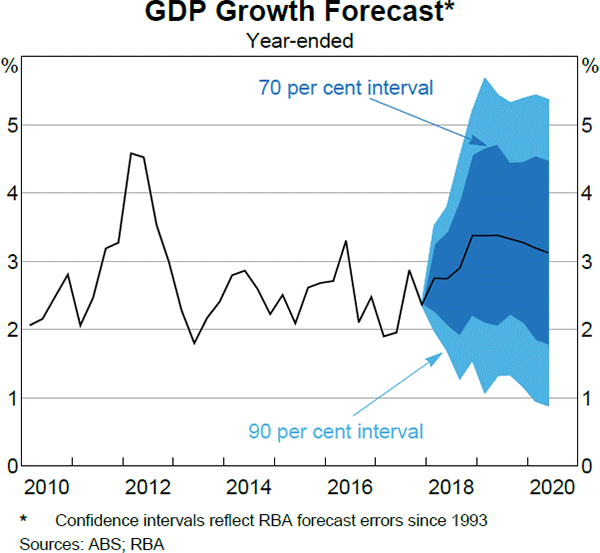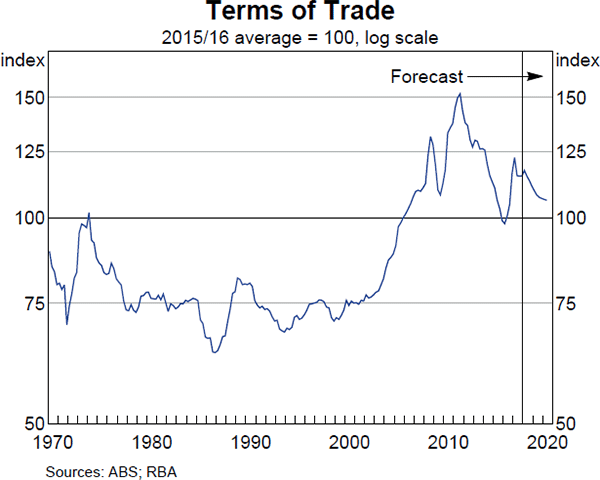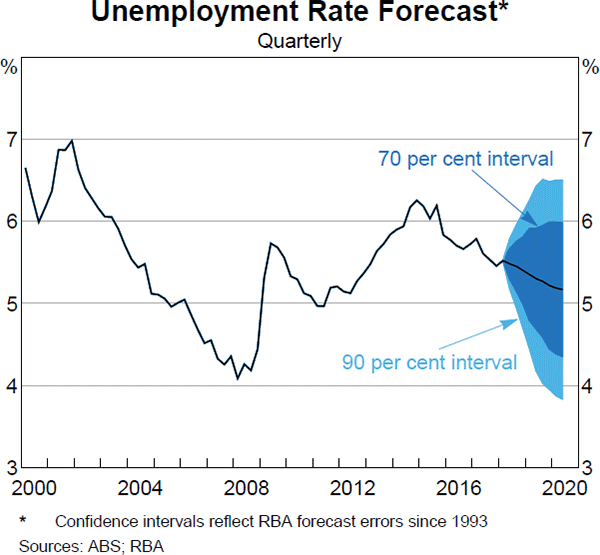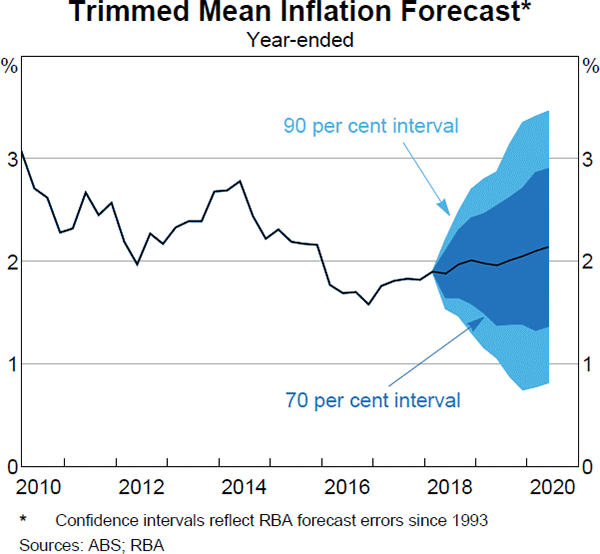Statement on Monetary Policy – May 2018 5. Economic Outlook
Overall, the forecasts are little changed from those presented in the February Statement on Monetary Policy. Growth in the global economy has been solid. Global inflation remains low, but is expected to increase as spare capacity diminishes, particularly in some major advanced economies. Indeed, there is a risk that inflation will pick up more quickly than is currently expected, which would have implications for monetary policy decisions and financial markets, as discussed below. Other important uncertainties around the global outlook include the potential for an escalation of trade tensions and the risks around the ability of Chinese authorities to balance the difficult trade-off they face between growth and managing other objectives, such as containing financial stability risks.
The starting point for domestic final demand growth is somewhat stronger than previously expected because there appears to have been more momentum in household consumption than suggested by initial estimates. Growth in the economy is expected to be around trend in the near term and to increase to be above 3 per cent for the remainder of the forecast period. Consistent with this, employment is expected to grow a little faster than the working-age population and the unemployment rate is expected to decline gradually, to 5¼ per cent. In this environment of diminishing spare capacity, wage pressures are expected to build and underlying inflation is expected to increase gradually from close to 2 per cent currently, to be above 2 per cent by the end of the forecast period. However, as discussed below, there continues to be considerable uncertainty about how much spare capacity there is in the economy, how quickly it might decline and how this might translate into wage and inflation pressures.
GDP growth is expected to be stronger in 2018 and 2019 than in 2017
Growth in the domestic economy is expected to strengthen over the forecast period (Graph 5.1; Table 5.1). Upward revisions to household consumption in previous quarters and stronger-than-expected non-mining business investment meant that domestic demand growth over 2017 was stronger than previously thought. Recent indicators point to consumption and non-mining business investment growth maintaining this momentum and exports recovering in the March quarter. Taken together, the available information implies that GDP growth is currently around estimates of potential growth in year-ended terms.

| Year-ended | ||||||
|---|---|---|---|---|---|---|
| Dec 2017 | Jun 2018 | Dec 2018 | Jun 2019 | Dec 2019 | Jun 2020 | |
| GDP growth | 2.4 | 2¾ | 3¼ | 3½ | 3¼ | 3 |
| Unemployment rate(b) | 5.5 | 5½ | 5½ | 5¼ | 5¼ | 5¼ |
| CPI inflation | 1.9 | 2 | 2¼ | 2¼ | 2¼ | 2¼ |
| Underlying inflation | 1¾ | 2 | 2 | 2 | 2 | 2¼ |
| Year-average | ||||||
| 2017 | 2017/18 | 2018 | 2018/19 | 2019 | 2019/20 | |
| GDP growth | 2.3 | 2¾ | 3 | 3¼ | 3¼ | 3¼ |
|
(a) Technical assumptions include A$ at US$0.75, TWI at 62 and Brent
crude oil price at US$71 per barrel; shaded regions are historical
data Sources: ABS; RBA |
||||||
The forecasts for domestic output growth are broadly similar to those presented in the February Statement. GDP growth is expected to strengthen a little over the next year or so as the drag from mining investment comes to an end and accommodative monetary policy provides ongoing support for sustained growth in household income and consumption, and non-mining business investment. However, the economy is not expected to encounter broad-based capacity constraints for some time. The implementation of the National Disability Insurance Scheme (NDIS) and public infrastructure investment are expected to continue to boost public demand. Dwelling investment is expected to remain at high levels, supported by a significant pipeline of work still to be done, but it is not expected to contribute to GDP growth over the forecast period.
GDP growth is expected to slow a little towards the end of the forecast period because liquefied natural gas (LNG) production will have reached its steady state. LNG exports are therefore not expected to contribute much to growth after 2019.
These forecasts are based on the technical assumption that the cash rate evolves broadly in line with market expectations, which is for no change until at least the middle of next year. The exchange rate and oil prices are assumed to remain at their current levels. This implies an exchange rate that is about 3 per cent lower on a trade-weighted basis than was assumed in the February Statement (and around 7 per cent lower than its mid-2017 peak) and a US dollar price of Brent crude oil that is about 11 per cent higher. The population aged over 15 years is assumed to grow by 1.7 per cent over 2018 and by 1.6 per cent over 2019.
A further pick-up in investment growth is likely …
A key development over 2017 was the strong pick-up in non-mining investment, led by strong growth in non-residential construction. The pipeline of non-residential construction work yet to be done and the first read of investment intentions from the Australian Bureau of Statistics (ABS) capital expenditure (Capex) survey for 2018/19 suggest non-mining business investment will remain solid over the coming year. Further into the forecast period, growth in private sector construction is expected to moderate somewhat, while other forms of business investment, particularly machinery & equipment and computer software, are expected to support growth, consistent with an ongoing economic expansion.
Public demand is also expected to provide impetus to investment growth for some time. As discussed previously, there are positive spillovers from strong growth in public infrastructure investment.[1] Growth in public and non-mining investment is expected to offset some further declines in mining investment as large LNG projects move to completion. The drag from falling mining investment is expected to have disappeared completely towards the end of the forecast period; recent data suggest the trough in mining investment may occur later in 2018 or early 2019 (compared to the Bank's expectation in February that it would be around the middle of this year).
… and the current pace of consumption growth is expected to continue
Upward revisions to household consumption over 2017 provide more confidence in the forecasts for consumption growth to remain around its current rate. This forecast is consistent with timely indicators of consumption such as retail sales and consumer sentiment. Further out, the forecast is in line with expected household income growth, which is predicated on ongoing improvement in the labour market and a gradual increase in wages growth. However, the outlook for growth in household income continues to represent a significant uncertainty (see below).
Exports are expected to rise as more LNG production comes on line
The decline in exports in the December quarter of 2017 appears to have been largely temporary; various supply factors that affected coal exports during 2017 are expected to be resolved in coming quarters, and rural exports fell in the December quarter due to poor weather. Growth in exports over 2018 and 2019 is expected to increase as additional LNG production comes on line and as growth in major trading partners underpins ongoing growth in service and manufactured exports. Imports are expected to remain strong as import-intensive parts of the economy continue to grow.
Chinese demand for bulk commodities, in particular iron ore, is expected to moderate in the period ahead, at the same time as low-cost producers increase supply. This is expected to lead to lower bulk commodity prices over the medium term. Consequently, the terms of trade are expected to decline over the medium term, but to remain above their trough in early 2016 (Graph 5.2).

The unemployment rate is expected to decline gradually
Over the March quarter, employment growth moderated from the very strong pace in 2017, as expected. Higher employment was met by a further increase in participation rather than a decline in the unemployment rate, which has been around 5½ per cent for some months. With GDP expected to grow at or above trend pace, employment growth is expected to be a little above growth in the working-age population over the next couple of years and spare capacity in the labour market is expected to decline. As such, the unemployment rate is still expected to decline gradually over the forecast period to around 5¼ per cent (Graph 5.3). The labour market is expected to still have some spare capacity at that point.

How fast the unemployment rate declines over the next few years will depend on the employment intensity of GDP growth, how many more people in the working-age population will be encouraged to participate in the labour force, and how far wages growth picks up. Importantly, there is uncertainty around the level of the unemployment rate that is consistent with full employment (that is, spare capacity in the labour market having been fully absorbed). If experience overseas is any guide, this level of the unemployment rate could turn out to be lower than previously assumed.
Labour cost pressures are expected to increase gradually
There is little change to the outlook for wages growth from the February Statement. Wages growth is expected to pick up gradually, as spare capacity in the labour market declines and as any effects of structural factors that are weighing on wages growth start to dissipate. Information from the Bank's liaison program suggests it is not likely that wages growth will decline further. Indeed, although the majority of firms expect wages growth to be largely unchanged over the next year, the share of firms who expect higher wages growth has continued to increase. Furthermore, it is anticipated that the gradual broadening of skill shortages will translate into higher wages growth at some stage. How quickly wages growth picks up will also depend on the award and minimum-wage decisions over the next few years and their influence on wage outcomes in the broader economy, as well as changes to the current caps on public sector wages growth.
Growth in average earnings per hour from the national accounts (AENA) – a broader measure of labour costs – has been much weaker than WPI growth over recent years, as the economy adjusts to the end of the mining boom. It is expected that AENA growth will pick up faster than WPI growth as the adjustment to the end of the mining boom dissipates and non-wage payments increase as the labour market strengthens. The extent to which a pick-up in wages growth will translate into inflationary pressures will depend on whether there is an accompanying increase in productivity growth. Productivity growth, as measured, has been relatively weak over the past year or so and is likely to have been affected by some of the compositional factors that have affected AENA growth.
Inflation is expected to pick up gradually
The March quarter inflation data were largely in line with the forecasts in the February Statement. Underlying inflation is expected to gradually increase from close to 2 per cent currently, to be above 2 per cent by the end of the forecast period (Graph 5.4). The forecasts reflect the expected decline in spare capacity in the economy as GDP growth picks up and as the labour market moves towards full employment. Weak retail prices as a result of the structural changes underway in the retail sector are expected to continue to weigh on inflation.

A key area of uncertainty for the inflation outlook is around how quickly wages growth picks up in response to improving labour market conditions. In terms of components of inflation, the outlook for retail prices also depends on whether consumer discretionary spending will continue to grow at a solid pace and how long the structural change underway in the retail sector continues to put downward pressure on prices. The outlook for the price of building a new dwelling depends on the residential construction industry's response to competition for labour and material inputs from the non-residential construction underway.
CPI inflation is expected to increase gradually to be a bit above 2 per cent in both 2018 and 2019. CPI inflation is expected to be a little higher than underlying inflation over the next few years. This is a result of the scheduled increases in the tobacco excise.
Domestically, risks are little changed, while some international risks have risen
A number of key uncertainties surround the forecasts. Domestically, the risks are similar to those discussed in the February Statement. There continues to be uncertainty about how much spare capacity is in the labour market and how quickly it might decline, particularly given the recent strength in the participation rate. There is also uncertainty about how much any decline in spare capacity will build into wage pressures and inflation. Wages and employment growth are key components of household income growth, and uncertainty about the outlook for household income growth translates into uncertainty about household consumption and so GDP. Another key source of risk to consumption growth is that high levels of debt are likely to increase the sensitivity of households' consumption decisions to changes in their income or wealth.
For the global economy, an escalation in protectionism measures or geopolitical events could harm global growth. At the same time, there is a risk that global inflation will be higher than expected, prompting a faster tightening of monetary policy and broader financial conditions in the major advanced economies. In China, while the pace of growth in new financing has declined, debt levels remain high and continue to pose downside risks to growth over the medium term.
Domestically, there is uncertainty about the degree of spare capacity in the labour market …
Despite very strong employment growth, there has been little change in the unemployment rate since mid 2017. This is because, on net, the increase in demand for labour has been more or less met by an increase in the number of people in the labour force (see ‘Box B: The Recent Increase in Labour Force Participation’). The central forecasts assume that the unemployment rate will remain around its current level in the near term before edging lower. However, leading indicators point to the possibility that the unemployment rate could fall faster than expected in the near term; the fact that GDP is expected to grow faster than trend over the forecast period is also consistent with this possibility.
There is always uncertainty around the estimate of the unemployment rate that is consistent with full employment, because it is unobserved and has to be inferred from the data on the unemployment rate and wages growth.[2] For example, the emergence of structural factors, such as a decline in labour's bargaining power or technological change, may be weighing on wages growth. Indeed, in many advanced economies, unemployment rates have fallen below earlier estimates of full employment without a noticeable pick-up in wage pressures. Other considerations for estimating how much spare capacity there will be in the labour market over the next few years include the level of underemployment in the economy, and how much further the participation rate could rise.
… and how this might translate into inflationary pressures
The outlook for a pick-up in inflation depends on a gradual pick-up in wages growth. If structural factors continue to put downward pressure on wages, it is less likely that there will be a sustained pick-up in underlying inflation. On the other hand, businesses are increasingly reporting skill shortages following a prolonged period of low wages growth, which may suggest that wages growth could pick up a bit faster than is currently forecast.
While labour costs are a key driver of inflationary pressure, competition in the retail sector has had a significant dampening effect on final prices; these effects on margins and final prices are expected to continue over the forecast period. The competition for market share in the retail sector has seen the introduction of new pricing strategies, which are likely to keep retail price inflation weak for some time, but it is difficult to predict when the process of adjusting to lower margins might be completed.
The outlook for consumption growth is also affected by uncertainty about the outlook for income growth …
Uncertainty about wages growth translates into uncertainty about the growth of household income, which is one of the main determinants of consumption growth. Recent data revisions indicate that household consumption has so far been more resilient to low income growth than suggested by the initially published data; consumption growth has been maintained by households reducing their saving rates.
Consumption growth gained momentum over the second half of 2017, coinciding with a period of strong employment growth and increased participation in the labour market, but ongoing weak growth in average wages. This is consistent with the possibility that the propensity to consume rather than save additional income is higher for those who were previously not working than it is for already employed workers increasing their hours. However, if households view lower income growth as highly persistent, consumption growth could be somewhat lower than forecast.
… and the high level of household debt
Household indebtedness is high; and debt levels relative to income have edged higher because household credit growth has outpaced weak income growth over recent years. Steps taken by regulators to strengthen household balance sheets have led to a moderation in the growth in the riskier types of lending to households, but risks remain. Even if overall household indebtedness currently appears sustainable, a highly indebted household sector is likely to be more sensitive to changes in income, wealth or interest rates. For example, a highly indebted household facing weaker-than-expected growth in disposable income or wealth is more likely to respond by reducing consumption. Consumption growth may also be weaker for a time if indebted households choose to pay down debt more quickly rather than consume out of additional income.
Housing assets account for around 55 per cent of total household assets, so weaker housing prices could be a factor that leads to weaker consumption growth than is currently forecast. National housing prices have eased following several years of strong price growth. To date, the cooling of conditions in the established housing market does not appear to have dampened consumption growth. Although the earlier gains in national housing wealth may not have encouraged much additional consumption, it is possible that households' consumption and saving decisions could be more sensitive to an easing in housing price growth.
Tighter lending standards could also affect the outlook for domestic growth. While APRA recently announced plans to remove the investor loan benchmark, the change in dynamics in the housing market and the high level of public scrutiny of lending decisions could see some tightening in the supply of credit. This could affect the outlook for consumption and dwelling investment.
Risks remain in the global economy that could affect trade
Tensions around global trade have increased over recent months, particularly between the United States and China (see ‘Box A: Recent Trade Protectionism Measures’ for further discussion of recent measures and their potential effects). The direct effect of the tariff measures announced so far, including on selected steel, aluminium and manufactured ‘high tech’ products, is expected to be modest because they affect only a small part of the bilateral trade between the United States and China. However, if there is an escalation of protectionist measures in the United States and its trading partners retaliate, it would harm global growth significantly, given the importance of the United States in the global economy. This could in turn lead to a loss of business confidence and lower investment that outweigh any positive effects on US growth arising from a substitution to domestic production. Also, economies at full employment may also see a substantial increase in inflationary pressures and tighter monetary policy. In the longer run, growth is likely to be lower than it would be otherwise because productivity growth is likely to be lower due to less cross-border competition.
Developments in China have some more direct implications for demand for Australian exports and Australia's terms of trade. The authorities are seeking to navigate a difficult trade-off between the near-term imperative to support growth (in line with their targets) and the need to contain financial risks. Financial conditions have tightened over the past year, reflecting measures to restrain leverage and reduce ‘shadow banking’ related risks through more stringent regulation. At the margin, this has helped ease the build-up of financial stability risks by dampening growth in non-bank financing and facilitating a shift in the composition of funding back towards more traditional bank lending.
However, parts of the Chinese economy have shown signs of softening of late – especially in the industrial sector – which could encourage the authorities to revert to a more accommodative policy stance. The way in which the fiscal and monetary policy mix is calibrated to address this trade-off poses risks in both directions for the forecasts. An easier policy stance could result in Chinese growth being stronger than projected in the near term, at the price of delaying deleveraging. On the other hand, tighter financial regulation in the period ahead could have more of a dampening effect on activity than expected. This could weigh on China's demand for bulk commodities, Australian exports and the terms of trade. Chinese economic policy is further complicated by current rising trade tensions with the United States, which pose downside risks both to Chinese exports and domestic demand if they should escalate
Global inflation could be higher than expected
Inflation pressures have been slow to emerge in many advanced economies despite ongoing solid growth and spare capacity having now been largely absorbed. In many advanced economies, growth is expected to remain robust and result in increasing pressure on capacity constraints, which could lead to a much more rapid pick-up in global inflation than currently expected. In the United States, the fiscal stimulus is expected to add to growth and could add more upward pressure on inflation than currently assumed, particularly given that economic conditions are already strong; fiscal stimulus on this scale is unusual in a non-recessionary period.
Wages growth in the United States has picked up only gradually to date but the pace could increase in the future, particularly as labour shortages become more widespread. More generally, wage pressures have not increased by as much as expected in many advanced economies, partly because labour supply has increased in response to strong demand through higher participation rates, especially for females and older people. However, there is limited scope for further sustained increases in participation. The strength of the global economy could also see more widespread inflation pressures emerge through higher global commodity prices than currently assumed.
These conditions could prompt a faster tightening of monetary policy and financial conditions in the major advanced economies than is currently expected. The prices of many financial market assets imply that broad-based global growth is expected to continue without a significant build-up of inflationary pressures. So a sharp rise in inflation, or inflation expectations, and the responses by central banks could prompt a significant adjustment in many asset prices, including by raising risk premia. This could result in losses for investors and less favourable funding conditions for businesses, households and governments, albeit against a backdrop of stronger growth. More broadly, higher interest rates, particularly in the United States, could result in capital outflows from emerging markets.
Footnotes
See ‘Box C: Spillovers from Public Investment’ in the February 2018 Statement on Monetary Policy. [1]
Cusbert T (2017), ‘Estimating the NAIRU and the Unemployment Gap’, RBA Bulletin, June, pp 13–22. [2]